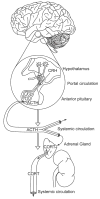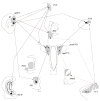Regulation of the Hypothalamic-Pituitary-Adrenocortical Stress Response
- PMID: 27065163
- PMCID: PMC4867107
- DOI: 10.1002/cphy.c150015
Regulation of the Hypothalamic-Pituitary-Adrenocortical Stress Response
Abstract
The hypothalamo-pituitary-adrenocortical (HPA) axis is required for stress adaptation. Activation of the HPA axis causes secretion of glucocorticoids, which act on multiple organ systems to redirect energy resources to meet real or anticipated demand. The HPA stress response is driven primarily by neural mechanisms, invoking corticotrophin releasing hormone (CRH) release from hypothalamic paraventricular nucleus (PVN) neurons. Pathways activating CRH release are stressor dependent: reactive responses to homeostatic disruption frequently involve direct noradrenergic or peptidergic drive of PVN neurons by sensory relays, whereas anticipatory responses use oligosynaptic pathways originating in upstream limbic structures. Anticipatory responses are driven largely by disinhibition, mediated by trans-synaptic silencing of tonic PVN inhibition via GABAergic neurons in the amygdala. Stress responses are inhibited by negative feedback mechanisms, whereby glucocorticoids act to diminish drive (brainstem) and promote transsynaptic inhibition by limbic structures (e.g., hippocampus). Glucocorticoids also act at the PVN to rapidly inhibit CRH neuronal activity via membrane glucocorticoid receptors. Chronic stress-induced activation of the HPA axis takes many forms (chronic basal hypersecretion, sensitized stress responses, and even adrenal exhaustion), with manifestation dependent upon factors such as stressor chronicity, intensity, frequency, and modality. Neural mechanisms driving chronic stress responses can be distinct from those controlling acute reactions, including recruitment of novel limbic, hypothalamic, and brainstem circuits. Importantly, an individual's response to acute or chronic stress is determined by numerous factors, including genetics, early life experience, environmental conditions, sex, and age. The context in which stressors occur will determine whether an individual's acute or chronic stress responses are adaptive or maladaptive (pathological).
Copyright © 2016 John Wiley & Sons, Inc.
Figures








References
-
- Accorsi-Mendonca D, Machado BH. Synaptic transmission of baro- and chemoreceptors afferents in the NTS second order neurons. Auton Neurosci. 2013;175:3–8. - PubMed
-
- Aguilera G. Regulation of pituitary ACTH secretion during chronic stress. Front Neuroendocrinol. 1994;15:321–350. - PubMed
-
- Aguilera G, Rabadan-Diehl C. Vasopressinergic regulation of the hypothalamic-pituitary-adrenal axis: implications for stress adaptation. Regul Pept. 2000;96:23–29. - PubMed
-
- Akana SF, Dallman MF, Bradbury MJ, Scribner KA, Strack AM, Walker CD. Feedback and facilitation in the adrenocortical system: unmasking facilitation by partial inhibition of the glucocorticoid response to prior stress. Endocrinology. 1992;131:57–68. - PubMed
Publication types
MeSH terms
Substances
Grants and funding
LinkOut - more resources
Full Text Sources
Other Literature Sources

